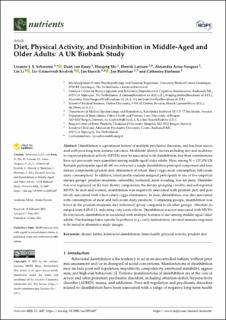| dc.description.abstract | Disinhibition is a prominent feature of multiple psychiatric disorders, and has been associated with poor long-term somatic outcomes. Modifiable lifestyle factors including diet and moderate-to-vigorous physical activity (MVPA) may be associated with disinhibition, but their contributions have not previously been quantified among middle-aged/older adults. Here, among N = 157,354 UK Biobank participants aged 40–69, we extracted a single disinhibition principal component and four dietary components (prudent diet, elimination of wheat/dairy/eggs, meat consumption, full-cream dairy consumption). In addition, latent profile analysis assigned participants to one of five empirical dietary groups: prudent-moderate, unhealthy, restricted, meat-avoiding, low-fat dairy. Disinhibition was regressed on the four dietary components, the dietary grouping variable, and self-reported MVPA. In men and women, disinhibition was negatively associated with prudent diet, and positively associated with wheat/dairy/eggs elimination. In men, disinhibition was also associated with consumption of meat and full-cream dairy products. Comparing groups, disinhibition was lower in the prudent-moderate diet (reference) group compared to all other groups. Absolute βs ranged from 0.02–0.13, indicating very weak effects. Disinhibition was not associated with MVPA. In conclusion, disinhibition is associated with multiple features of diet among middle-aged/older adults. Our findings foster specific hypotheses (e.g., early malnutrition, elevated immune-response) to be tested in alternative study designs. | en_US |

